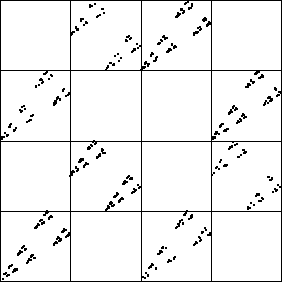
Recall the
coarse-graining
methods of driving an IFS. Here we use the equal-size bins.
The
| bin 4 | 3/4 <= x <= 1 |
| bin 3 | 1/2 <= x < 3/4 |
| bin 2 | 1/4 <= x < 1/2 |
| bin 1 | 0 <= x < 1/4 |
Here is the driven IFS - not random at all, lots of structure. Can we understand its pattern?

|
Return to IFS Driven by Dynamical Systems.